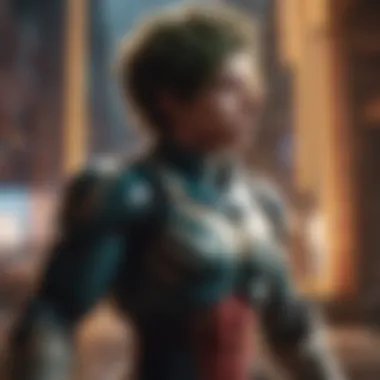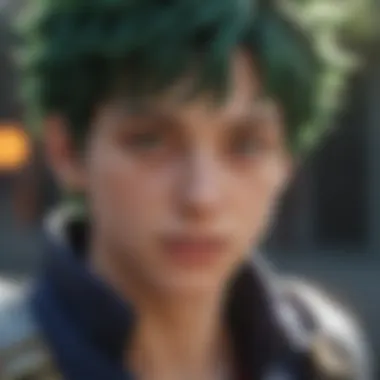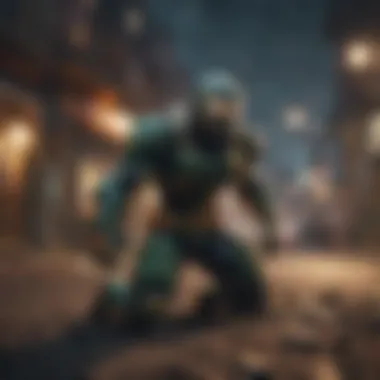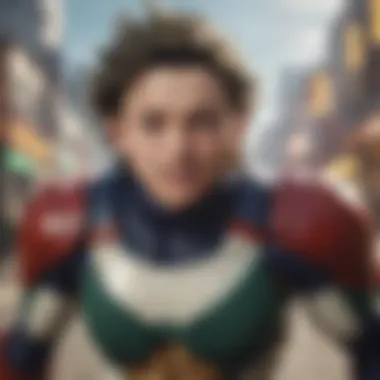A Comprehensive Analysis of My Hero Academia Season Five


Intro
My Hero Academia has captivated audiences with its unique blend of superhero elements and character-driven storytelling. Season Five continues this tradition, diving deeper into the lives of heroes and villains alike. This season presents a critical juncture: it not only expands on the existing lore but also introduces fresh challenges and moral dilemmas that test the resolve of our beloved characters.
In this analysis, we will unravel pivotal plot developments, examine character arcs, and delve into the thematic richness that Season Five offers. What are the motivations behind characters' actions? How do these narratives set the stage for future seasons? Join us as we navigate through the intricate world of My Hero Academia, shedding light on its significance within the broader context of the series.
Intro to My Hero Academia
The introduction of any significant series sets the stage for understanding its broader impact. In this context, My Hero Academia serves as a vital focal point of contemporary anime culture. The series not only captivates audiences but also enriches discussions surrounding heroism, morality, and personal growth.
Overview of the Series
My Hero Academia, created by Kohei Horikoshi, debuted in 2014. The anime follows Izuku Midoriya, a boy born without superpowers in a world where nearly everyone possesses a unique ability, known as a Quirk. Society's dynamics, underpinned by these powers, dictate social status and identity. As Midoriya strives to become a hero, notions of perseverance, sacrifice, and friendship dominate the narrative. The series explores the hero society's complexities while presenting relatable characters, making it resonate with a wide audience.
The journey through U.A. High School, a prestigious institution for aspiring heroes, offers a lens into Midoriya’s growth and the trials faced by his classmates. The animation, character design, and world-building contribute significantly to its success, allowing viewers to invest deeply in the characters and their collective struggles.
Significance of Season Five
Season Five of My Hero Academia marks a pivotal junction in the series, solidifying themes and character developments from previous seasons. As the narrative progresses, viewers witness a maturation of characters and escalated conflicts. This season intricately weaves together personal and external challenges. The stakes are higher, prompting a deeper exploration of the characters' motivations and aspirations.
Notably, Season Five focuses on the impact of mentorship and rivalry, with Midoriya continuing to learn from established heroes like All Might and facing off against intense rivals. This season intricately deepens the viewer's understanding of the complexities of heroism, shifting it beyond mere superhuman abilities to encompass emotional resilience and ethical dilemmas. It is within this structured progression that the elements of teamwork and loyalty are emphasized, making Season Five a critical examination of interpersonal relationships and personal growth.
Season Five crucially expands the narrative and thematic landscape of My Hero Academia, inviting viewers to reflect on what being a hero truly means.
The analysis of this season provides insightful avenues to comprehend not just the characters' growth, but also the overarching moral questions posed by their journeys.
Plot Summary of Season Five
The plot summary of Season Five of My Hero Academia serves as a crucial segment in understanding the overall narrative and character development within the series. This season is marked by significant events that shape the trajectory of its characters and set the stage for future arcs. Key aspects include the introduction of new storylines, the escalation of conflicts, and a deeper exploration of existing relationships. This summary provides necessary context and clarity, helping both fans and critics appreciate the complexity of the show's developments.
Key Arcs and Storylines
Season Five introduces several key arcs that drive the narrative forward. The Joint Training Arc stands out prominently, highlighting the competition between Class 1-A and Class 1-B. This arc serves not just as a display of power and abilities but also as a means to explore the individual strengths and weaknesses of the characters. It provides fans with insights into how teamwork and understanding can shape a hero's journey.
The Meta Liberation Army Arc also plays a vital role late in the season. This arc creates tension with the emergence of new villain factions, posing a serious threat to the heroes. The convergence of heroes and antagonists creates a compelling storyline that captivates viewers.
These arcs enhance the depth of My Hero Academia, showcasing how each character learns and evolves through their experiences. As the stakes rise, the development of abilities and strategies becomes crucial in this examination of growth.
Climactic Moments
Climactic moments in Season Five possess a significant impact on the narrative's progression. One pivotal moment occurs during the climax of the Joint Training Arc, where unexpected alliances and rivalries develop. This moment encapsulates not just the intensity of their training but also the evolution of personal relationships among students.


Another essential climactic moment is the confrontation involving the Meta Liberation Army. The impact this combat has on the main characters builds anticipation for future developments. With stakes raised high, fans are left questioning the outcomes of these battles.
"These encounters are not merely action sequences; they are transformative experiences for the characters, shaping their identities as heroes."
In summary, the plot summary of Season Five provides a detailed framework through which fans can appreciate the various arcs and climactic moments as integral to character development and narrative progression.
Character Development in Season Five
Character development is a foundational aspect of storytelling, particularly in My Hero Academia Season Five. This season provides a nuanced exploration of growth for various characters, thereby enhancing the audience's emotional engagement. The evolution of characters not only drives the plot forward but also enriches the thematic undercurrents present in the series. As the narrative unfolds, it positions personal growth in the context of larger societal challenges, allowing viewers to relate more deeply to the characters’ journeys.
Protagonists' Growth
The protagonists undergo significant transformations in Season Five. Izuku Midoriya, the primary character, showcases a deeper understanding of his powers and responsibilities. His training regimen intensifies, and he starts to grasp the importance of wisdom alongside strength. This juxtaposition emphasizes a critical aspect of heroism: being strong is not enough; one must be wise and just.
Similarly, characters like Katsuki Bakugo and Shoto Todoroki experience pivotal developments. Bakugo’s journey is marked by a struggle to balance his aggressive instincts with a newfound sense of teamwork. His interactions with his classmates reveal layers of complexity that previously remained hidden. On the other hand, Todoroki grapples with his family legacy, and his growth is encapsulated in his quest for self-identity amidst external expectations. This evolution fosters a richer narrative experience for viewers.
Antagonists' Evolution
In contrast to the protagonists, the antagonists also see noteworthy development in Season Five. Characters like Dabi and Hawks emerge with greater depth, revealing their motivations and backstories. Dabi’s pursuit of revenge against the hero society creates a compelling narrative arc that challenges the viewer's moral compass. This complexity transforms him from a mere villain into an anti-hero, blurring the lines of good and evil.
Hawks, too, faces moral dilemmas that complicate his role as a hero. His dual identity becomes a focal point, as viewers witness his internal struggle between loyalty to the heroes and the grim realities of the world he navigates. This layered portrayal of antagonists stands in stark contrast to the traditionally clear-cut villain roles, enhancing the overall narrative.
Supporting Characters' Impact
Supporting characters play a critical role in shaping the protagonists’ journeys throughout Season Five. Characters like Ochako Uraraka and Tsuyu Asui provide essential emotional support that fosters growth and resilience among their peers. Uraraka’s development from a timid girl to a strong confidant illustrates the importance of friendship and collaboration.
Furthermore, the importance of mentorship is exemplified through figures like Eraser Head and Gran Torino, who guide the young heroes in honing their skills. Their influence emphasizes the theme that growth is often a shared journey, highlighting how one character's progress can inspire another.
"Strength does not come from winning. Your struggles develop your strengths. When you go through hardships and decide not to surrender, that is strength."
– Arnold Schwarzenegger
Themes Explored in Season Five
The exploration of themes within Season Five of My Hero Academia plays a critical role in enriching the narrative and deepening character interactions. Themes such as friendship, courage, and morality shape the experience of viewers and provide a lens through which to understand relationships and conflicts that arise. Each theme resonates with both the characters and the audience, offering layers of meaning that enhance the overall storytelling.
Friendship and Loyalty
Friendship and loyalty serve as a foundational theme in Season Five. This theme underscores the relationships between characters, showcasing how bonds are not only formed but also tested. The friendships established early in the series continue to evolve, pushing characters to their limits. Important scenes highlight how friends support one another in times of crisis. For example, during training exercises and battles, the unity among heroes is palpable. Characters such as Izuku Midoriya and Ochaco Uraraka exemplify the strength derived from trust and mutual respect.
"True friendship can withstand any trial. It is not the absence of differences that defines a friendship, but rather the capacity to stand united despite them."
Season Five emphasizes that loyalty goes beyond mere camaraderie; it involves sacrifices and going above and beyond for one's friends. This theme directly impacts the character development and alters the dynamics of personal growth. It challenges each character to reflect on their values and priorities in their pursuit to become true heroes.
Courage and Sacrifice


The theme of courage and sacrifice permeates key moments throughout the season. Characters face daunting obstacles that test their bravery. The narrative presents the notion that courage is not the absence of fear but the decision to act despite it. Protagonists like Shoto Todoroki and Bakugo Katsuki constantly grapple with their fears while striving to protect their peers.
Sacrifice also appears prominently in defining what it means to be a hero. Characters demonstrate that achieving personal goals may require putting others first. This selflessness is not only inspiring but also contributes to the integrity of the heroes’ ambitions. The series effectively illustrates how courage can emerge in moments when characters step up, even at personal cost, to safeguard their ideals and allies.
Morality and Justice
Morality and justice form a pivotal theme that influences several story arcs in Season Five. With the emergence of new villains, the boundaries of right and wrong become increasingly blurred. Characters confront ethical dilemmas that question their beliefs. This season raises significant questions about what it means to be just in a world filled with gray areas where traditional definitions of heroism may be challenged.
Throughout Season Five, philosophical conversations amongst characters prompt reflection on the broader implications of their choices. The struggle with moral ambiguity is evident, particularly in the actions of both heroes and villains. By examining their motivations, viewers are invited to engage with complex issues pertaining to justice. This engaging exploration encourages a dialogue about heroism and the moral fabric that underpins societal values.
In summary, the thematic exploration in Season Five of My Hero Academia allows for a deeper understanding of character motivations and relationships. Friendship, courage, and morality all intertwine to create a narrative that is not only compelling but also thought-provoking.
Cinematic Techniques and Animation Quality
Cinematic techniques and animation quality play a crucial role in the overall effectiveness of any animated series, especially one as intricately woven as My Hero Academia. This season stands out, not just for its compelling story arcs, but also for the manner in which visual storytelling is employed. The aesthetic choices, the fluidity of animation, and the sound design all combine to enhance the viewing experience, allowing the narrative's emotional weight to resonate more powerfully with audiences.
Visual Aesthetics
One of the defining features of Season Five is its visual aesthetics. The creators have maintained a distinct art style while elevating its execution to new heights. Each character’s design is sharp and detailed, showcasing their unique quirks through color and form. The use of vibrant palettes reflects the series' themes, steering the audience’s emotional engagement. Furthermore, backgrounds and settings are richly illustrated, providing a vivid context to the unfolding events.
Lighting also plays a key role in visual storytelling. Strategic use of shadows and highlights helps to create mood and atmosphere. For example, in intense scenes, darker tones heighten the sense of urgency, while bright, saturated colors may signify hope or triumph. This adept manipulation of visuals ensures that audiences remain captivated throughout each episode.
Action Sequences
The action sequences in Season Five of My Hero Academia remind viewers why this series has become a benchmark in animated superhero storytelling. The choreography is both elaborate and meticulously planned. Every clash and explosion feels invigorating and consequential. The animators' attention to detail shines, as each hero's quirk is dramatized with unique visual styles, ensuring each battle is not just entertaining but also distinct.
Moreover, the incorporation of dynamic camera angles adds depth. For instance, aerial perspectives during aerial battles provide context and scale to confrontations, giving the audience a comprehensive view of the action. This technique accentuates the intensity of the confrontations, making them feel more engaging and immersive.
Sound Design and Music
Sound design is another integral aspect of the season that deserves attention. The audio complements the visuals perfectly, creating an immersive experience. Sounds of urban life, background ambiance, and the specific effects of quirks deepen the viewer's sense of reality within the hero world. Every punch and blast has a weight, crafted through careful audio editing.
Music further amplifies the emotional aspect of the narrative. The series' soundtrack, composed by Yuki Hayashi, varied from upbeat to somber tones that directly reflect the scenes being portrayed. During climactic moments, music builds tension. In quieter scenes, it enhances the emotional undertone, allowing for a greater connection to character struggles.
"An animated series is only as powerful as its ability to transport the viewer into its world, and My Hero Academia excels through its unmatched combination of animation and sound."
Critical Reception and Audience Feedback
The critical reception and audience feedback are significant aspects that can enhance our understanding of My Hero Academia Season Five. Analyzing how critics and viewers perceive the season provides valuable context. This evaluation fosters a deeper appreciation of the series, revealing how various elements resonate with diverse audiences. It also showcases the show's ability to adapt and evolve over time, which is vital for retaining fan engagement. Collectively, these insights contribute to the overall dialogue about the franchise's development.
Critical Reviews
Critical reviews of Season Five reveal a mixture of praise and constructive feedback. Many critics highlighted the intense character development and the strong emotional undertones that permeated the narrative. The season’s focus on the intricacies of heroism and the moral dilemmas characters face struck a chord with many observers. For example, reviewers from sources like IGN and Collider lauded the balance between action and character introspection. Some critiques, however, pointed out pacing issues and felt that certain plot elements were rushed or lacked depth.


"The fifth season stands out for its character arcs while occasionally stumbling over its pacing."
Overall, critics recognized that while not flawless, the season’s rich storytelling and animation made it a compelling chapter in the series.
Viewer Ratings and Comments
Viewer ratings for this season further underline its positive reception. Platforms like MyAnimeList and Crunchyroll show high scores from fans, with many praising the evolution of established characters and the introduction of new ones. Viewers have expressed their admiration for how relatable the characters have become. Comments from fans often emphasize the emotional connection they felt during key moments in the season. Common themes in viewer feedback included appreciation for the growth of Izuku Midoriya and Shoto Todoroki, along with curiosity about upcoming challenges in future episodes.
This collective feedback not only distinguishes My Hero Academia Season Five but also sets expectations for subsequent installments. By evaluating viewer sentiments, we can gauge the successful aspects of the narrative while identifying areas for potential improvement.
Future Implications for the Series
Understanding the future implications of Season Five of My Hero Academia is crucial for comprehending how the narrative and character arcs will evolve. This season sets a foundation that influences not just the immediate plot progression but also the long-term directions for both protagonists and antagonists. By dissecting the elements introduced and the conflicts that arise, viewers gain insight into the trajectory that historians and analysts of the series will follow in their evaluations.
Setting Up for Season Six
Season Five strategically lays the groundwork for the upcoming Season Six. Major plot points are introduced, weaving new threats and challenges for the heroes. The relationship dynamics between characters intensify, highlighting individual motivations that propel them into future confrontations. It is evident that the stakes will increase, particularly as the 'Paranormal Liberation Front War' arc gains momentum. Key characters, such as Izuku Midoriya and Shoto Todoroki, are poised to confront formidable opponents in the coming season. This setup invites viewers to consider how established rivalries will transform and the role they will play in shaping the series going forward.
Additionally, unresolved plot threads in Season Five create expectancy and speculation. For example, the ambiguity surrounding the League of Villains’ plans and their impact on the heroes’ society will serve as a central theme that connects the two seasons seamlessly.
Character Trajectories Beyond Season Five
The character development shown in Season Five significantly impacts how those characters will navigate the changing landscape that Season Six will present. Heroes learn from their encounters and failures, showing resilience. For example, Bakugo Katsuki’s growth is not just about becoming stronger; it reflects a deeper understanding of teamwork and responsibility. Such evolution hints at how characters will respond to greater challenges in the future.
On the other side, antagonists also exhibit significant arcs, exhibiting complexities that are likely to unfold further. Characters like Tomura Shigaraki grow in danger as they become more influential in the series. Understanding his motivations and plans will be crucial as the storyline progresses.
The varied paths characters will take create rich opportunities for future storytelling. The audience will be keen to explore how friendships will evolve or whether old rivalries will reignite. Ultimately, the trajectories set in Season Five feed into the larger narrative that promises to be engaging and multifaceted.
"As character development flourished in Season Five, the anticipation for their journeys in the next season reaches a peak, fueling viewer engagement and interest."
Ending on Season Five
The conclusion of Season Five of My Hero Academia serves as a crucial framework for understanding the overarching narrative and character development within the series. Here, the culmination of various plot arcs intertwines with established themes, resulting in a comprehensive reflection on the season's significance. This section elucidates the critical elements that define the conclusion, emphasizing the interplay between growth, conflict, and the potential trajectory of future episodes.
Summarizing Key Insights
In summarizing the key insights gained from Season Five, it becomes evident that several pivotal aspects stand out:
- Character Development: The characters not only faced external challenges but also underwent significant internal transformations. This season highlighted their individual journeys, showcasing resilience and the evolution of their moral compasses.
- Thematic Depth: Friendship, loyalty, and sacrifice emerged as dominant themes in the season's narrative tapestry. These elements resonate strongly with viewers, prompting discussions about values in a society teeming with conflict.
- Narrative Arc Clarity: The series has demonstrated a remarkable ability to weave complex narratives that remain coherent and engaging. The focus on key arcs, particularly in their interrelation with previous seasons, reflects careful planning by the creators.
"Understanding Season Five's conclusion enriches the viewer's appreciation of the series as a whole, revealing nuances that might otherwise be overlooked."
Each of these insights contributes to the multifaceted nature of My Hero Academia and reaffirms its place in contemporary anime discourse.
Final Thoughts on its Place in the Franchise
Reflecting on the place of Season Five within the My Hero Academia franchise reveals its noteworthy contributions. This season reinforces previous work while diversifying character interactions and lore. The following considerations are critical:
- Bridging Future Arcs: The events of Season Five not only wrap up crucial conflicts but also set up expectations for Season Six. This foresight creates an anticipation that enhances viewer investment in the ongoing storylines.
- Cultural Impact: As My Hero Academia continues to expand in popularity, each season builds upon its cultural relevance. Season Five has contributed to discussions about heroism in modern society, positioning the franchise as a thought leader within the anime genre.
- Legacy of Character Relationships: The intricate relationships formed and challenged throughout Season Five leave a lasting impact on the audience. These connections elevate the franchise's emotional resonance.







